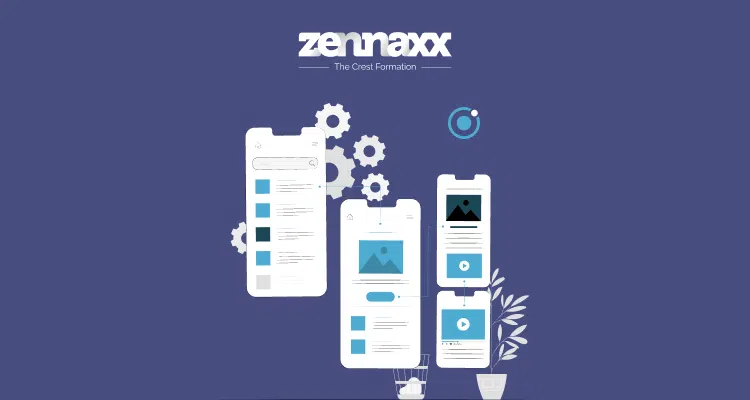Drifty Co. innovated the Ionic Framework in the year 2013. By 2015, developers had built over 1.3 million apps using Ionic.
The Ionic Framework became popular in the global dev community in just two years. It was groundbreaking tech that remained highly regarded.
PWA developers preferred the Ionic framework. It used service workers for offline access, push notifications, and caching. It also enabled background updates.
A service worker was a script that ran in the background, independent of the web or PWA. It responded to events like network requests, push notifications, and connectivity changes.
In this blog, we understand detailed information about the Ionic Framework and its features, which made it a top choice for PWA developers.

The Advent of Progressive Web Apps
Experts hailed PWAs as a revolutionary advancement in mobile app technology. They filled the gap between mobile web apps and native apps. Web apps were lightweight but had limited browser functions and needed the internet.
Native apps could send push notifications and work offline. PWAs combined the best of both worlds. They gave a seamless, app-like experience on the mobile web. They did this using various technologies, design principles, and web APIs.
A 2017 survey by Ionic found a significant change in development practices. The hybrid approach to mobile app development was now more popular than native coding.
Native tool reliance dropped sharply among developers, from 20 to 2.9 percent. This shift showed a growing preference for frameworks like Ionic.
Native apps had robust features, like offline use and push notifications. Mobile web apps were smaller and only available online.
But, they mimicked many native apps’ features. PWAs are the future of mobile apps. They stand with native apps and, in many ways, surpass them.
Before PWA tools and frameworks, developers had to code natively. They needed to build separate apps for Android, iOS, or Windows.
Each required a different development process. Ionic revolutionized this by enabling hybrid apps. They mimicked native apps but ran on multiple platforms using a single codebase.
The Ionic frameworks had a huge impact on the dev community. It made hybrid app development mainstream and accessible.
It simplified and unified the development process across platforms. So, it was a key innovation in mobile app development.
What was the Ionic Framework?
The Ionic frameworks is a fully open-source, 100% free SDK for hybrid mobile app development. This framework provides tools and services for building hybrid mobile apps.
It uses web technologies like CSS, HTML5, and JavaScript. These hybrid apps can be in all native app stores. This makes them versatile and accessible.
Ionic is also known for its support of PWAs. They receive praise for their advanced features and smooth user experiences.
Ionic lets developers use over 120 native device features. These include HealthKit, Fingerprint Authorization, and Bluetooth.
This feature set includes Cordova plugins and TypeScript extensions. They simplify development and enable high-performing, complex apps.
The framework works with native device functions. So, developers can build apps that feel truly native using a single codebase.
The Ionic community was vibrant and robust. It fueled rapid growth and adoption. Developers appreciated its open-source nature, which fostered innovation and collaboration.
Ionic’s comprehensive docs, extensive libraries, and active community helped developers. So, it became a popular choice for both novice and experienced developers.
The Benefits of Building PWAs with the Ionic Frameworks
Using the Ionic Frameworks to build PWAs has many benefits. It is a great choice for developers. Here are the key benefits:
1.Comprehensive Functionality
Ionic provides all the functionalities in native mobile development SDKs. This means developers can create apps that run on any OS, whether Android, iOS, or Windows.
By leveraging Cordova, these apps can also be deployed as native applications.
2.Command Line Interface (CLI)
Ionic includes a robust CLI. It lets developers build and test apps on any platform. This tool boosts productivity. It streamlines development and eases app lifecycle management.
3.Angular Integration
Ionic works perfectly with Angular. It’s a top framework for building dynamic web apps. It gives developers a rich set of components and services. They can use them to create highly interactive, responsive user interfaces.
4.Efficient Scrolling with Collection Repeat
A key feature of Ionic is its collection repeat function. This feature allows for smooth scrolling of large lists without performance degradation.
It creates a scrollable container. Developers can use a native-like delegate system to interact with it. This ensures a seamless user experience.
5.SASS-Based UI Components
SASS serves as the foundation for Ionic. It has many UI components for building advanced, robust apps. These pre-designed components speed up development. They ensure a consistent, appealing UI.
6.Cross-Platform Capabilities
Ionic’s hybrid approach lets developers write code once. They can then deploy it on multiple platforms. This cross-platform compatibility saves time and money. It’s a cost-effective solution for app development.
7.Performance Optimization
Ionic’s use of web technologies ensures that PWAs are functional and fast on all devices. These technologies include CSS, HTML5, and JavaScript.
This optimization is crucial for delivering a smooth and engaging user experience.
8.Active Community and Support
Ionic has a vibrant community and extensive documentation. They help developers solve problems and stay updated. This active ecosystem fosters innovation and collaboration, enhancing the development experience.
The Ionic Framework is great for building PWAs. It has a powerful CLI, Angular integration, and efficient scrolling.
Its SASS-based UI components and cross-platform features are excellent. It is well-optimized for performance and has an active community.
These benefits make Ionic a powerful tool. It creates high-quality, feature-rich apps that provide exceptional user experiences.
Some of the Successful Examples of PWA with Ionic.
PWAs are changing the digital world. They combine the best of web and mobile apps. What makes PWAs so successful?
And why is Ionic software their preferred choice? Let’s explore and look at some software And its Ionic’s capabilities.
Impressive Success Stories with PWAs
- Tinder cut its load time from 11.91 to 4.69 seconds with a PWA. It also made the app 90% smaller than its native Android version. Ionic-built PWAs can perform faster and save device storage.
- Facebook saw a big jump in engagement and downloads after expanding to PWAs. A PWA’s performance and accessibility can boost user engagement and retention.
- Uber developed a PWA optimized for speed, even on 2G networks. The main app is only 50K gzipped and loads in under 3 seconds. This shows Ionic’s power to create high-functioning, lightweight apps for users with limited connectivity.
- Pinterest: After launching their PWA, they saw a 60% rise in core engagements, a 44% jump in ad revenue, and a 40% increase in users’ time on their site. This case highlights how PWAs can enhance user engagement and monetize content more effectively.
- BookMyShow launched a PWA that loads in less than 3 seconds, resulting in an 80% increase in conversion rates. Their PWA is 54 times smaller than their Android app and 180 times smaller than their iOS app. This shows the efficiency and performance benefits of using Ionic software.
Curious about PWA development with Ionic?
Why Choose Ionic Software for PWAs?
1. Cross-Platform Compatibility
2. Optimized Performance
Ionic’s PWAs are meant to load quickly. They should do this even on slow networks and sometimes without the internet. Ionic’s effective cache management and minimal code ensure apps run fast. They feel native without being bulky.
3.Rich Developer Ecosystem
The Ionic software supports popular frontend frameworks like Angular and React. It also lets you use many pre-built components and plugins. This diverse world of libraries speeds up app creation. It can guide developers in creating unique, attractive UIs without reinventing the wheel.
4. Scalability and Flexibility
Whether it’s a small startup or a large corporation, Ionic software can be expanded. It increases the number of users compared to the normal software.
What are the alternatives to Ionic application development services for PWA development?
Many other frameworks and platforms exist for Ionic software. They are for Progressive Web App (PWA) development. Here’s a look at some of the leading alternatives:
1. Xamarin
Xamarin is a Microsoft-supported framework for cross-platform mobile apps. It uses C# and . NET. Developers can share up to 90% of the code between platforms, resulting in the same performance as on the native platform.
It is a good choice for Microsoft developers. It works well with Visual Studio and provides access to native APIs.
2. React Native
An official Facebook product called React Native lets you use JavaScript and React.js to make mobile apps. It also has reusable parts and hot reloading for quick development, giving users a nearly native experience.
3. Flutter
Flutter from Google is one UI toolkit that can be used to create natively compiled apps for desktop, web, and mobile from a single codebase.
4. Cordova
Apache Cordova is an open-source framework. It lets developers build mobile apps using standard web technologies wrapped in a native container.
Conclusion
One of the most common technologies is Progressive Web Apps. The Ionic platform backs them and is the most trustworthy in software development.
Many companies have adopted Ionic software. It’s better than a native one in speed and flexibility. It stays running into the slower network services.
Are you thinking about making your software smoother and more flexible? Zennaxx Software Solutions can help you create powerful, cross-platform apps. Contact us to learn more about how we can assist you in implementing Ionic software.


